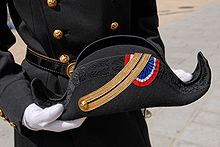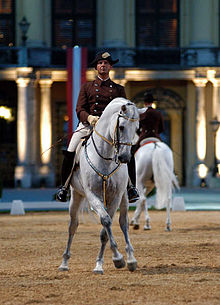- Bicorne
-
- For the mythical beast, see Bicorn (monster).
 Napoléon Bonaparte in his characteristic bicorne hat
Napoléon Bonaparte in his characteristic bicorne hat
The bicorne or bicorn (two-cornered) is an archaic form of hat widely adopted in the 1790s as an item of uniform by European and American military and naval officers. It is now most readily associated with Napoléon Bonaparte but in practice most generals and staff officers of the Napoleonic period wore bicornes, and it survived as a widely worn full-dress headdress until at least 1914.
Contents
Historic use
 Grand Admiral Alfred von Tirpitz wearing a bicorne
Grand Admiral Alfred von Tirpitz wearing a bicorne
Descended from the tricorne, the black-coloured bicorne originally had a rather broad brim, with the front and the rear halves turned up and pinned together (in English the shorter front brim was called 'the cock' - hence 'cocked hat' - and the longer rear brim was termed 'the fan'), forming a semi-circular fan shape; there was usually a cockade in the national colours at the front. Later, the hat became more triangular in shape, its two ends became more pointed, and it was worn with the cockade at the right side. This kind of bicorne eventually became known in the English language as the cocked hat, although to this day it is still known in the French language as the bicorne.
 The full-dress uniform of École Polytechnique of France comprises black trousers with a red stripe (a skirt for females), a coat with golden buttons and a belt, and a cocked hat (officially called a bicorne).
The full-dress uniform of École Polytechnique of France comprises black trousers with a red stripe (a skirt for females), a coat with golden buttons and a belt, and a cocked hat (officially called a bicorne).
Worn in the side-to-side "athwart" style during the 1790s, the bicorne was normally seen "fore-and-aft" in most armies and navies from about 1800 on. This change in style coincided with the flattening out of the pronounced front peak of the original headdress.
Some forms of bicorne were designed to be folded flat, so that they could be conveniently tucked under the arm when not being worn. A bicorne of this style is also known as a chapeau-bras or chapeau-de-bras.
The bicorne was widely worn until World War I as part of the full dress of officers of most of the world's navies. It survived to a more limited extent between the wars for wear by senior officers in the British, French, US, Japanese and other navies until World War II but has now almost disappeared in this context.
In addition to its military/naval uses, the bicorne was widely worn during the nineteenth and early twentieth centuries by civilian officials in European monarchies and Japan, when required to wear uniforms on formal occasions. This practice generally ceased after World War I but British colonial governors in temperate climates and governors general in some countries of the Commonwealth (notably Australia, Canada and New Zealand) continued to wear bicornes with ceremonial dress until the second half of the twentieth century.
Current use
On formal occasions such as a prorogation speech, the Lord Chancellor of the United Kingdom wears a tricorne hat, but the other Lords Commissioners wear bicorne hats.
Members of the Académie française wear the habit vert (green habit) at the Académie's ceremonies. The habit includes a black jacket and a bicorne in the cocked-hat style, each embroidered in green.
Students at the Ecole Polytechnique wear a bicorne as part of their Grand Uniforme (GU). Female students used to wear a tricorne hat but now also wear a bicorne. The bicorne also formed part of the historic black and red full dress of cadets at the French Military Medical School ("Ecole de Sante des Armées") until this uniform was withdrawn in 1971, except for limited use on special occasions. The bicorne is still worn by the members of the Cadre Noir in full dress uniform.
The uniform of the horsemen of the Spanish Riding School of Vienna includes a bicorne.
Diplomatic uniforms worn on such occasions as the presentation of credentials by ambassadors normally included bicornes worn with feathers and gold or silver braiding. Until World War II such uniforms were worn by even junior embassy staff but now survive only for ambassadors in a few long-established diplomatic services such as those of Britain, France, Belgium and Spain.
At the annual Trooping the Colour in London, British generals taking part in the ceremony wear the scarlet-and-blue full dress of their rank, which includes a bicorne. Certain officers of the Brigade of Guards who hold administrative positions such as that of quartermaster wear bicornes (described as cocked hats) in full dress instead of the usual bearskin.
Cocked Hat
Military Knights of Windsor wearing cocked hats.
"Cocked hat" is another name for the bicorne. As such it was a style of formal headgear, or hat, worn by certain civilian, military and naval officials from the early 19th century until the beginning of World War II.
In its most commonly seen form the cocked hat was pinned up at two sides to form a hump-back bridge shape and was worn perpendicular to the shoulders, with the front end above the face and the back end over the nape. A cockade in the national colours might be worn at the right side (French tradition) and a plume might be attached to the top (British military c.1800); the cocked hat was often trimmed with gold or silver bullion lace and tassels. Naval officers wore this hat without further decorations, but those worn by military and civilian officials might be lavishly decorated with coloured ostrich or swan feathers.
Idiom
To be knocked into a cocked hat is to be soundly and swiftly defeated.
See also
- List of hats and headgear
- Chapeau
- Tricorne
- 1813 cartoon showing men with collapsible bicornes tucked under their arms
Categories:- Hats
- History of clothing (Western fashion)
- Military uniforms
- History of clothing (Europe)
Wikimedia Foundation. 2010.


